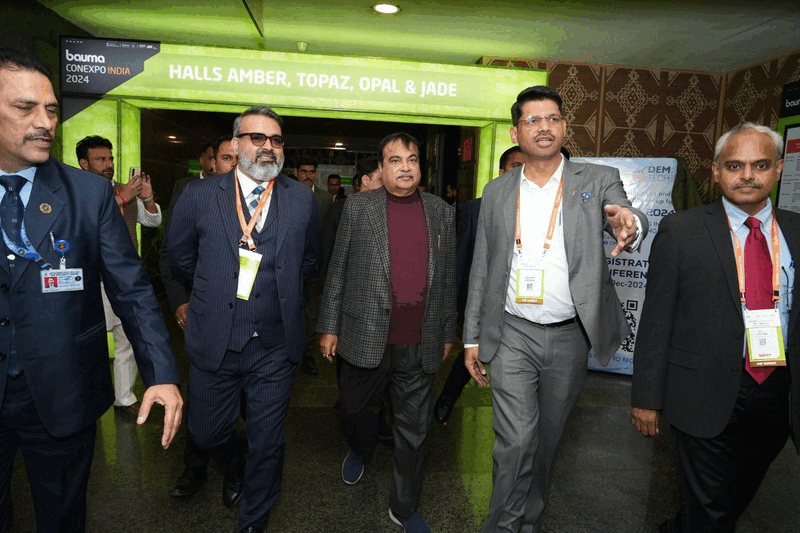New 21 LC 660 Flat-Top tower crane

Anmopyc News
28 May 2012
Most of its design is based on the successful 21 LC 750 model, and includes new improvements
The 21 LC 750 tower crane, launched in 2009, has been one of Linden Comansa’s most succesful models, mainly due to the innovative design of the slewing part, and the easiness of its assembly. A similar design has been applied in the 21 LC 660 tower crane, which doesn’t have apex element either, as the first jib and counterjib sections are assembled together directly over the slewing platform through fast conections, which saves time, reduces costs in auxiliary equipment, and improves the safety.
Both jib and counterbib sections that form the slewing head of the 21 LC 660 are, which provides an easier assembly of the crane, and shortens the counterjib of the 21 LC 660 three meters in comparison to the 21 LC 750. Most of the jib sections of the 660 are the same of the 750, which increases the modularity and the possibilities of section interchangeability between both cranes.
For the tower of the 21 LC 660, a new mast section has been designed, named D35, which is more economic than the tower section at the 21 LC 750 (D36). Both have the same dimensions (5.5m high and 2.5m wide - 18 ft high and 8.2 ft wide), which makes them compatible and able to share the same hydraulic jacking cage. The D35 mast sections can be divided in four panels, are easy to assemble and transport, and are easily joined to other sections by pins.
Two standard tower configurations have been created: The first one uses only D35 tower sections, allowing the crane to achieve a freestanding height of 73.3 meters on fixing angles (240 ft), or 69.9 on stationary or travelling base (229 ft). The second configuration combines D35 with D36 sections, and allows the 21 LC 660 to reach a height of 78.8 meters on fixing angles (258 ft), and 80.9 on base version (265 ft). Furthermore, the enormous modularity of the different tower sections from Linden Comansa allows many alternative configurations, which makes possible to the 21 LC 660 to reach a freestanding height of 124.8 meters (409 ft).
Compatibility is one of the characteristics that Linden Comansa stamps in all of its cranes, and the trolley-hook set of the 21 LC 660 is a new example, as it is the same as the 21 LC 550 or the 21 LC 750, depending on the model: the 18 t version of the 21 LC 660 has the set of the 21 LC 550 18 t, and the other three versions use the same set than the three versions of the 21 LC 750: 24, 36 and 48 t.
The experience acquired with the 21 LC 750 has led to some improvements on the new model, such as expanding the transit zone at the slewing part, or placing all the electrical components and converters in one single cabinet, at the platform of the cabin, which allows easy maintenance labors.
Regarding the mechanisms, the 21 LC 660 features the latest systems developed by Linden Comansa, assuring an efficient work and the best performance:
- Effi-Plus high speed hoist mechanisms, which allow hoist speeds up to 244 meters (800 ft) per minute.
- PowerLift System, which improves 10% the load diagram with reduced speeds.
- Slewing mechanisms with Frequency Control, to make the most of the energy and allowing less consumption.
The standard hoist engine, with 110 kW (148 hp), has a Lebus drum with capacity for 1,450 meters of rope (4,747 ft). Other two engines, with rope capacity of 790 meters (2,592 ft) and with 110 and 65 kW (87 hp) respectively, are available as optional.
Both jib and counterbib sections that form the slewing head of the 21 LC 660 are, which provides an easier assembly of the crane, and shortens the counterjib of the 21 LC 660 three meters in comparison to the 21 LC 750. Most of the jib sections of the 660 are the same of the 750, which increases the modularity and the possibilities of section interchangeability between both cranes.
For the tower of the 21 LC 660, a new mast section has been designed, named D35, which is more economic than the tower section at the 21 LC 750 (D36). Both have the same dimensions (5.5m high and 2.5m wide - 18 ft high and 8.2 ft wide), which makes them compatible and able to share the same hydraulic jacking cage. The D35 mast sections can be divided in four panels, are easy to assemble and transport, and are easily joined to other sections by pins.
Two standard tower configurations have been created: The first one uses only D35 tower sections, allowing the crane to achieve a freestanding height of 73.3 meters on fixing angles (240 ft), or 69.9 on stationary or travelling base (229 ft). The second configuration combines D35 with D36 sections, and allows the 21 LC 660 to reach a height of 78.8 meters on fixing angles (258 ft), and 80.9 on base version (265 ft). Furthermore, the enormous modularity of the different tower sections from Linden Comansa allows many alternative configurations, which makes possible to the 21 LC 660 to reach a freestanding height of 124.8 meters (409 ft).
Compatibility is one of the characteristics that Linden Comansa stamps in all of its cranes, and the trolley-hook set of the 21 LC 660 is a new example, as it is the same as the 21 LC 550 or the 21 LC 750, depending on the model: the 18 t version of the 21 LC 660 has the set of the 21 LC 550 18 t, and the other three versions use the same set than the three versions of the 21 LC 750: 24, 36 and 48 t.
The experience acquired with the 21 LC 750 has led to some improvements on the new model, such as expanding the transit zone at the slewing part, or placing all the electrical components and converters in one single cabinet, at the platform of the cabin, which allows easy maintenance labors.
Regarding the mechanisms, the 21 LC 660 features the latest systems developed by Linden Comansa, assuring an efficient work and the best performance:
- Effi-Plus high speed hoist mechanisms, which allow hoist speeds up to 244 meters (800 ft) per minute.
- PowerLift System, which improves 10% the load diagram with reduced speeds.
- Slewing mechanisms with Frequency Control, to make the most of the energy and allowing less consumption.
The standard hoist engine, with 110 kW (148 hp), has a Lebus drum with capacity for 1,450 meters of rope (4,747 ft). Other two engines, with rope capacity of 790 meters (2,592 ft) and with 110 and 65 kW (87 hp) respectively, are available as optional.
 Earthmoving, Compaction, Materials handling and Transport
Earthmoving, Compaction, Materials handling and Transport
 Machinery for Mining and Construction Special Works
Machinery for Mining and Construction Special Works
 Plants and Machinery for the Production of Construction Materials
Plants and Machinery for the Production of Construction Materials
 Light and Auxiliary Equipment
Light and Auxiliary Equipment
 Lifting Equipment for Persons and Loads
Lifting Equipment for Persons and Loads
 Auxiliary Equipment and Elements
Auxiliary Equipment and Elements
 Components, Spare Parts and Accessories
Components, Spare Parts and Accessories



